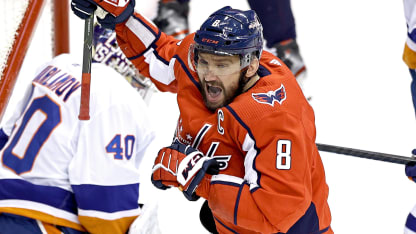Igor Shesterkin, Ilya Samsonov, Ilya Sorokin, Iaroslav Askarov, Alexandar Georgiev, Pyotr Kochetkov, Ivan Fedotov. What is in the water in Russia? How are they producing so much promising talent in net? -- @theashcity
The influx of Russia-born goalies became a hot topic when Andrei Vasilevskiy of the Tampa Bay Lightning and Anton Khudobin of the Dallas Stars faced each other in the Stanley Cup Final, and after the Nashville Predators made Askarov the highest-selected Russia-born goalie by taking him with the No. 11 pick in the 2020 NHL Draft.
The trend will continue this season with Shesterkin and Georgiev sharing the New York Rangers net, Samsonov expected to ascend to the Capitals' No. 1 job, and Sorokin's arrival with the New York Islanders.
Kochetkov, a second-round pick (No. 36) by the Carolina Hurricanes in the 2019 NHL Draft, and Fedotov, a seventh-round pick (No. 188) by the Philadelphia Flyers in the 2015 NHL Draft, could join the wave in the future.
NHL.com goalie guru Kevin Woodley points to the role played by legendary Russian goalie Vladislav Tretiak after he was elected president of the Russian Ice Hockey Federation in 2006. Tretiak, who was inducted to the Hockey Hall of Fame in 1989, instituted rules and financial incentives to ensure there were spots for Russian goalies in the Kontinental Hockey League and to discourage teams from using foreign goalies. That also forced Russian programs to develop goalies at the lower levels to fill those spots.
"Goalie coaching has certainly improved, and that is also widely cited, but it hasn't been nationalized or institutionalized at too young an age," Woodley said in an email. "And many of the goalies we see having success now started at a young age with old-school teachings that stressed skating and skills-based work, while being left on their own to develop their instinctual abilities to play, read and react to the game."
How about one for fun: winners and losers of the Reverse Retro alternate jerseys for 2020-2021 season? Also, would it be good for the League to try something like this again but maybe all new designs for every team? -- @raman_noob
I've always preferred the alternate jerseys that were throwbacks or honored the team's history in some way. The Reverse Retro jerseys, which each of the 31 NHL teams will wear in multiple games this season, do that while modernizing the old look with a fun, new twist.
The Colorado Avalanche jersey is the best example, and judging by the reaction on social media, it is the most popular. The white sweater with Avalanche maroon trim recognizes the franchise's Quebec Nordiques roots with their igloo logo and fleur-de-lis.
The Hurricanes did the same with their history, taking the Hartford Whalers' home jerseys from their inaugural NHL season in 1979-80, but with gray instead of white as the primary color. The Pucky the Whale shoulder patches are a nice touch.
My next two favorites are the Los Angeles Kings' and New Jersey Devils'. The Kings combined their original Forum Blue and Gold colors with the Wayne Gretzky/1990s era logo. The Devils used their original red, white and green jerseys, but with green replacing white (home) and red (road) as the primary color.
As for your suggestion of doing this again with each team coming up with an original jersey design, I would be against that. If you have too many different looks too often, you end up like the University of Oregon football team, which has so many different uniform combinations they are sometimes unrecognizable.

